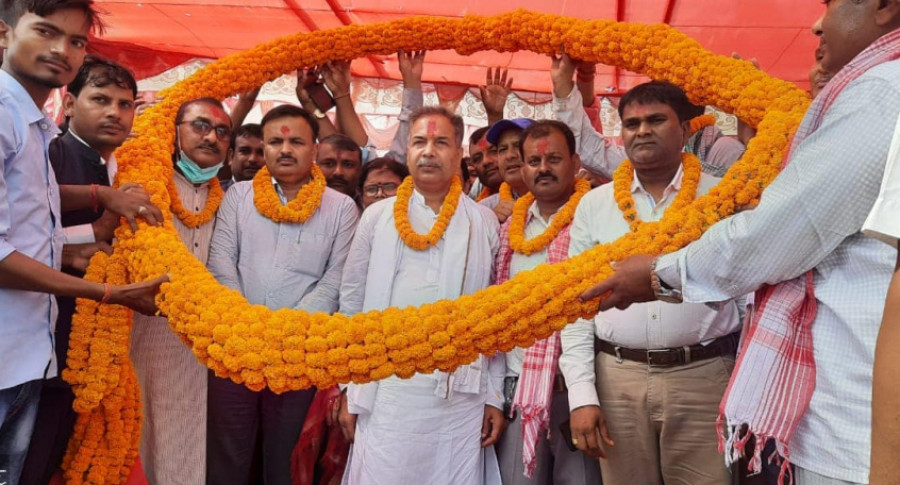Columns
Devolution of sycophancy
With federalism giving rise to new power centres, ‘chakari’ culture has taken newer forms.
Avasna Pandey
In BP Koirala’s short story "Doshi Chasma", Keshav Raj, a commoner, visits an army general’s house to pay his obeisance every day. But one day, his faulty glasses fail him, and he cannot recognise the general as he passes by. Having failed to offer his swasti at an opportune moment, Keshav Raj worries he might have angered the jarsaab, while it later turns out that the general had not even noticed him.
Keshav Raj is a quintessential Nepali sycophant. Sycophancy has long sustained the hierarchical and feudal nature of Nepali society. Anthropologist Dor Bahadur Bista in Fatalism and Development writes that chakari, or sycophancy, was an integral part of the social organisation in Nepal. And it has to a large extent become coextensive with the informal structuring of Nepali organisations—it is a way for information to be passed throughout the organisation outside formal channels. So embedded is the act in the system that anyone who refuses is considered to be attempting to disrupt the social organisation.
The fault in our status
The promise of social media was that it would give everyone a voice. So it did, to a significant extent. But it also turned us into exhibitionists, as we constantly market ourselves by showcasing our associations particularly with influential people. Hence, we post every picture with authorities to wish them on their birthdays and anniversaries, and we congratulate them for inaugurating projects and writing poems. Our captions adulate them even more, as we sing paeans to the glory of the leaders—adaraniya buwa, dai, didi and so forth—not to mention the garlands we offer them, often used to pay homage to leaders, which have become synonymous with cheap publicity. On social media, the voice of reason is lost somewhere, and the platform has mostly turned into a circus-like snafu, or rather the new proscenium, where wanting to be part of the show, we often bow and scrape.
The exhibition of chakari on social media is just a new iteration of what has long remained a part of Nepali culture, politics and society. Tracing the genealogy of the chakari culture might lead us to the establishment of Nepal Mandala itself, but a cursory look at the past few decades is enough to understand that it is a culture we have inherited well from our former rulers. Rana rule sustained itself through the servitude of sycophants. It was on the basis of sycophancy that the Ranas delegated power and position to bureaucrats. The more dedicated the sycophant, the higher the reward. It was on the basis of servitude and patronisation that the baksis culture flowered. Once the Rana regime was gone, the monarchy once again became the centre of power, in effect, of the culture of sycophancy. Those who fell out of favour of the monarchs lost political legitimacy, to the extent of being considered a threat to the institution of monarchy itself.
With the re-establishment of multi-party democracy, the power of the durbar waned significantly as political parties were now in a position to wield power over state mechanisms. And after 2015, when federalism ensured the devolution of power centres to multiple locations across the country, the culture of sycophancy devolved as well. Today, with the devolution of power to provincial and local levels, there are multiple locations where the transaction of sycophancy and patronage can be exercised. In other words, sycophancy is adaptive in all forms of power relationships, from authoritarian to democratic. It is hydra-headed; it does not die away easily and keeps appearing in various avatars.
Bista in his book points out that sycophancy is an act to be performed publicly; but public spheres have gone through a sea change since the anthropologist put forth his views. Thanks to technology, public spheres are no longer limited to physical spaces like palaces and khopis, but have come to constitute digital spaces as well. Today, Facebook, Instagram and Twitter offer arguably more effective platforms for sycophants to pay their allegiance to the patrons and exhibit such an allegiance for the consumption of the public. It wouldn’t be an exaggeration to claim that these new spaces provide fertile ground for neo-chakari to take place. How we practise sycophancy might have changed over the years, but it has not been eliminated from society. As prisoners to structures and attitudes that demand submission, many of us continue to become real-life Keshav Rajs, and would serve as poignant subjects for a re-assessment of Bista’s theory in the digital age.
The legitimising effect
State formation and formation of identity complement each other. Our identities—as citizens, lawmakers, professors or sycophants—are formed through a historical process through which a particular self comes into being. A culture that prioritises personal relations over merit and critical thinking inhibits us from exercising our agency as citizens. Instead, it forces us to worship those who expect servitude in exchange for even the simplest tasks of public service delivery. As institutions and bureaucracy become increasingly dysfunctional, the "people" have nothing more than selfies and pictures taken with their elected representatives to get promotions, admissions, contracts, political appointments and so on. This reliance is pitiful, but aptly portrays our state-society relation.
The relationship between the sycophant and the patron is a mutually beneficial one. By hobnobbing around the power centre, the sycophant projects an image of himself or herself as someone who has access to power. And in doing so, the sycophant ends up legitimising the power of the patron. The patron, meanwhile, continues the relationship with the sycophant because there is legitimacy to be derived from that relationship. In that sense, it is not a relationship entirely based on dominance and subjugation, but on a transaction of legitimacy in a society that values power and patronage.
The culture of sycophancy needs to be stemmed if we are to change society for the better, but given our current state of affairs, it seems like a distant dream. We have changed the system of governance at the macro level, and this might give the impression that our society and culture is changing too. But inside this story of change lies the notion of continuity, a feudal mindset that seems to be working to either accumulate power or exercise it in various ways through different channels. What we need is a complete overhaul of how we understand politics, public service delivery and social relationships. Otherwise, what we will have is only a marketplace of self-interests and transactional exchanges. A country without a soul.




 12.12°C Kathmandu
12.12°C Kathmandu













%20(1).jpg&w=300&height=200)

